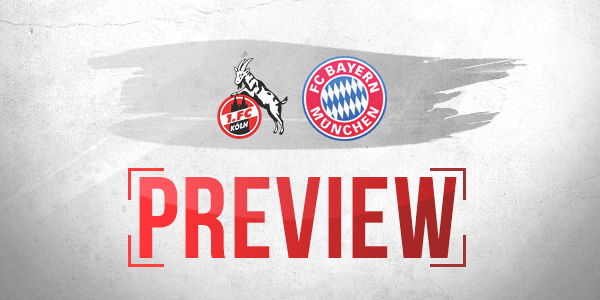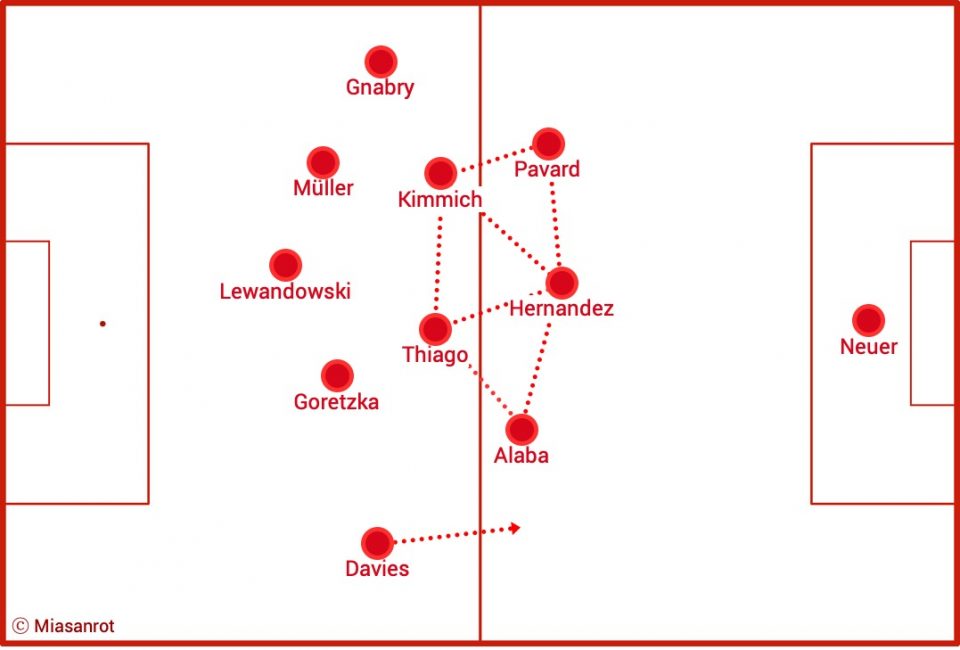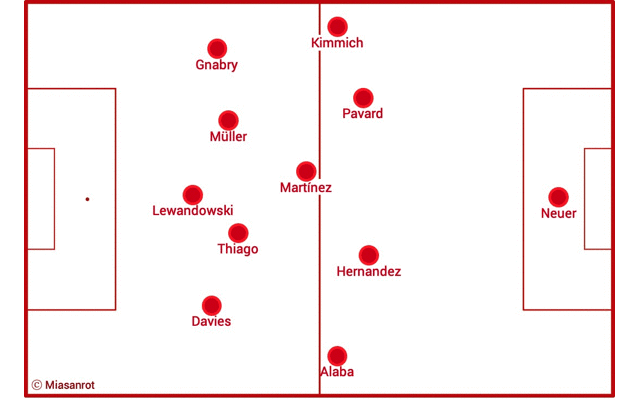Bundesliga MD 22 Preview: Cologne against Bayern
13th place with six points above the relegation zone and in touching distance to a mid-table position – you would have been called mad predicting a development like this at Cologne just a few weeks ago. They were 17th after matchday 11 with three points adrift of safety. Two wins, one draw, and eight defeats was their devastating track record up to that point.
Then came Markus Gisdol and Horst Heldt, two veterans very familiar with relegation battles. They both have seen their fair share of them over the long course of their careers. And indeed: A look at the Bundesliga table since Gisdol’s appointment sees Cologne in 5th place. So far, Gisdol has collected five wins, two draws, and only three defeats in 10 games. That adds up to 17 points, only five fewer than Bayern over the same period – with a game in hand (last weekend’s postponed fixture against Gladbach).
So is Cologne against Bayern in truth a thriller in waiting? Not quite, because also under Gisdol Cologne have struggled against the top teams. Leipzig beat them 4-1 and Dortmund even managed to put five past them. However, especially at home Cologne has developed a certain degree of stability under Gisdol, which might prove the crucial difference in their quest to stay up. Since Gisdol has taken over, Cologne’s home record reads four wins, one draw, and no defeat, including a 2-0 win against Champions League hopefuls Leverkusen.

FC Cologne en route to staying up?
But how has Gisdol managed this turnaround? A key factor is that he first shored up the defense. Under Beierlorzer, Cologne pressed very aggressively at times and only allowed the opponent to play an average of nine passes in their own half before they took a defensive action. With Gisdol on the bench, this figure has risen to about eleven passes on average. In the ten matches under his tutelage so far, Cologne has conceded 15 goals, with nine of them falling in the games against Leipzig and Dortmund alone.
StatsBomb’s expected goals model has measured 13.1 expected goals against in this period, and 8.1 in 8 games if the two extreme cases Leipzig and Dortmund are excluded. In the home game against Leverkusen, however, the team proved that it can also effectively suffocate strong offensive lines. Leverkusen only achieved 0.2 expected goals against Cologne.
Under Beierlorzer, Cologne conceded 23 goals in eleven games with 16 expected goals against. His football also thrived on pressing, but his side often failed to fall back into their defensive shape quickly enough once the opponent overcame their first pressing line. Now, starting from a more compact and deeper defense, the team is expected to force turnovers by keeping the spaces in central midfield very tight. If they manage to win the ball this way, they usually push up their players quickly. With Mark Uth and Jhon Córdoba, they have two players who are currently in very good form. While Uth is very important in creating Cologne’s attacking game, especially because of his many space-opening runs, Córdoba is a reliable goal scorer, especially at home (7 goals in his last 6 home games).
How can Cologne trouble Bayern?
Against Bayern, Gisdol will most likely start his team in his favored 4-2-3-1 formation. Without the ball, Cologne defends with two narrow lines of four, with the midfield line sometimes even augmented to five. We will probably not see Cologne venture an all out attacking style in transition. Usually, they use three or four players to carry out a counter-attack. This makes it difficult to hit them on the counter on a break.
As Julian Nagelsmann tried to do last weekend, Gisdol will be looking to exploit the spaces behind Bayern’s full-backs as soon as his side wins the ball. On the left, Ismail Jakobs, only 20 years old, has been playing more frequently of late, and he could use his pace to good effect against a slowing Jérôme Boateng, should he play. On the right, Gisdol used Jan Thielmann in five of the last six games. The 17-year-old was able to convince especially with his work rate and defensive diligence, but he did not have too much influence on Cologne’s attacking game.

One option for Cologne to deploy this strategy would be through Kingsley Ehizibue, who as right-back could push up from the back and provide the width when the winger in front of him tucks in. But Cologne are not really dangerous building-up down their right wing. In most cases, they create chances down the left or through the center if they have space on the break. Cologne is also very dangerous from set pieces. They have already scored 12 goals from dead ball situations, whereas only 15 came from open play (four of which on counter-attacks). Under Gisdol, Cologne scored 17 times at 15.1 expected goals. This does not exactly indicate a dazzling display of offensive fireworks whenever they go forward, but at least it speaks for a good efficiency in front of goal.
FC Bayern: Will the right side be a problem?
From Bayern’s point of view, it is of course important to prevent counter-attacks by Cologne. As it always is the case against such opponents, it will be important for Bayern to keep the game going at a brisk pace and not be averse to taking risks, while at the same time avoiding to fall for Cologne’s traps. Their current place in the standings hides how strong this team really is to a certain extent. Five victories from the last six games should be enough of a warning.
However, Cologne’s defeat against Dortmund revealed the team’s limits. If Bayern can replicate the level of pressure they were able to produce over the last few weeks against Cologne too, they should get a decent amount of chances in the game. Against Cologne’s well organized defensive line, it will be important to act quickly and assured in possession.
Flick’s task, however, is mainly to stabilise his team’s stability in defensive transition. On the left wing, he has a “get out of jail free” card with Alphonso Davies, who even from a very high position is still able to track back in time to make a challenge when his team loses the ball. There is no such player on the right. If Benjamin Pavard is involved in attack high up the pitch, there is often no backward protection on his side. Boateng has repeatedly shown that he alone is not equal to this task. In many places, Joshua Kimmich is called upon as a right defender because he has more penetrating power going forward.
But what is often forgotten in this debate: When the 25-year-old still played mainly at right-back, he was often heavily criticized for his lack of working back to defend. In some cases, the gaps he left behind were even bigger than those by Pavard now, because Kimmich often used to charge forward all the way to the opponent’s baseline.
Tactical adjustments?
Álvaro Odriozola does not yet seem to play a major role at Bayern, which raises the question of a tactical adjustment rather than a personell change to address this problem. When two players as dissimilar as Kimmich and Pavard exhibit the same problems under different coaches, the problem may lie elsewhere. Incidentally, Bayern have already displayed a good tactical approach in recent weeks, but without consistently implementing it.

On the one hand, asymmetrical full-backs could solve the problem of either Lucas Hernández or David Alaba having to play at right center-back, which is not the best position of either one. On the other hand, the rear areas on the wings might be better protected if Pavard played with more restraint going forward when he has the ball.
Davies could use his freedom to move forward, in which case the team’s defensive shape would be a staggered 3-2, which has already worked to good effect several times this season. Kimmich and Thiago would also no longer have to drop between the center-backs and would be able to maintain their positions better.
The clear disadvantage of this setup is that on the right, at least in theory, there is no one to provide support with overlapping runs down the wing. What is needed here is a flexible number eight like Thomas Müller or Leon Goretzka, who could regularly drift out in support. Whether this would in turn lead to problems in the center would have to be tested in practice. Additionally, a setup like this would deprive Bayern of the possibility that one of their holding midfielders (usually Kimmich) drops in between the center-backs to open up space for the other one. This is why such an asymmetrical formation could be problematic, especially against smaller teams.
A third possibility would be to use Bayern’s default approach with Kimmich dropping off – but into the right center-back position so that Hernández could shift to the centre and Alaba to the half left. This would also result in a back three, but Thiago as the sole holding midfielder would need the support of a number eight (Goretzka last time) all the more. It would then be important for the team to push up in an organized fashion when building up from the back to keep the center in the second and final third sufficiently occupied.
The return of Javi Machinez?
Another chance is the imminent return of Javi Martínez, who has not yet recovered from his torn muscle injury, but should resume training with the team in the coming weeks. The Spaniard could return to his former midfield position and thus remedy a number of problems all at once. Now some will surely be surprised that I, of all people, see Martínez in midfield, but let me explain before you send me your outraged mails in complaint:

How about a hybrid javi? If he plays in a role that has him move back and forth between midfield and central defense, he might be able to capitalize on his strengths and bypass his weaknesses. When Bayern are in possession, it would make sense for him to drop between the central defenders. There, the pressure is usually lower and he also would not be a key figure in Bayern’s build-up play, because the left and right center-back positions are more decisive here due to the diagonal passing angles to the outside.
But who will now take up his position in defensive midfield? It is simple: Alaba moves to left-back and Kimmich to right-back. When Bayern have the ball, they both push towards the center to support Thiago during build-up play. This would provide a strong presence in midfield and also ensure a solid protection in the game against the ball with three defensively very accomplished players.
It is unclear how good Davies is as an offensive player when he has no support in front of him. Lately, he showed one or two limitations in the final third. But again, without putting this to the test, the feasibility of such an approach cannot be judged definitively. It may well be that the tightening of the center opens up space for the wingers further upfield as a consequence.
The last chance to tinker and tweak for a while?
With all due respect to a very resurgent Cologne side, this game and the next against Paderborn offer Flick and Bayern the last chance to make adjustments and try out a few things on the pitch before the business end of the season finally kicks in. We are not talking major changes here. Both our tactical thought experiments only differ from Bayern’s actual current setup in details.
At any rate, Bayern are too susceptible to counter-attacks down their right-hand side at the moment and it is up to the coaching team to come up with an answer to that as soon as possible. Gisdol and his team will want to capitalize on this weakness by shifting the focus of play to their left flank, which is their stronger side anyway.
If Bayern manage to escape possible threats down their right flank unscathed, nothing should stand between them and success – except themselves. But a victory on Sunday is not a matter of course. Cologne have been too stable for that in recent weeks. In any case, the match will not be one of these classic encounters with a relegation candidate you so often see, and Bayern should be prepared for that.












The “Martinez as libero” experiment is one I expected so much in the Pep era, a pity it was never really materialized, mostly due to him being unavailable. I think with Bayern’s current personnel, such idea indeed makes a lot of senses.
“being unavailable” as in Pep seemed fixated on him being a Central defender instead of a box to box or defensive midfielder?…the position he was brought originally to Bayern for? I remember his season ending injury when he took a cross in the BvB box on the volley going for goal, and scheisskopf “smelly” schmelzer decided it would be a good idea to throw his body in front of Javi’s following thru leg…as usual with BvB, or now Leipzig, no foul, no penalty. I digress, but Javi was amazing as a guard dog and an offensive threat. I believe his first appearance for Spain was as a substitute for no less than Xavi in the 2010 WC and next, Xabi Alonso… not a bad vote of confidence for that position in a team like Spain at that time who, incidentally, won the WC.
“Being unavailable” as in him being unavailable everytime I thought finally it was time for Martinez to claim back his spot and importance in the team under Pep. He was sidelined for most of the first Pep season as you said, then when he was back at the end of the season, he had a great pokal final match vs Dortmund, as the central defender of a back 3, where we won 2-0 during extra time, only to be injured again in the summer, missing the whole preseason. He got another 2 months injury that season, spring time during busiest schedule, etc, and by the time Pep already did a lot of experiments with libero-Alaba, false fullbacks, Kimmich as central defender etc. As for him being seen as a box to box midfielder, I don’t think so, it only happens 1 or 2 times under special circumstances most notably the 3-0 win over Klopp’s Dortmund November 2013.
Now, watching Hernandez play yesterday vs Koln makes me nervous again about our defense. I know he’s still quite rusty coming back from injury, but his cameo vs Leipzig 1 week earlier was so much better.
The fact that Flick experimented with a back 3 last night vs Paderborn makes me remember you mentioned this idea in this article. But does not seem to have much potential? Both our pressing and wingplay suffered, and yet the back 3 was complacent and let in some chances of which they conceded 2 times. Of course we can attribute it to personnel (Ordiozola’s performance, familiarity, and lack of concentration) but what do you think?